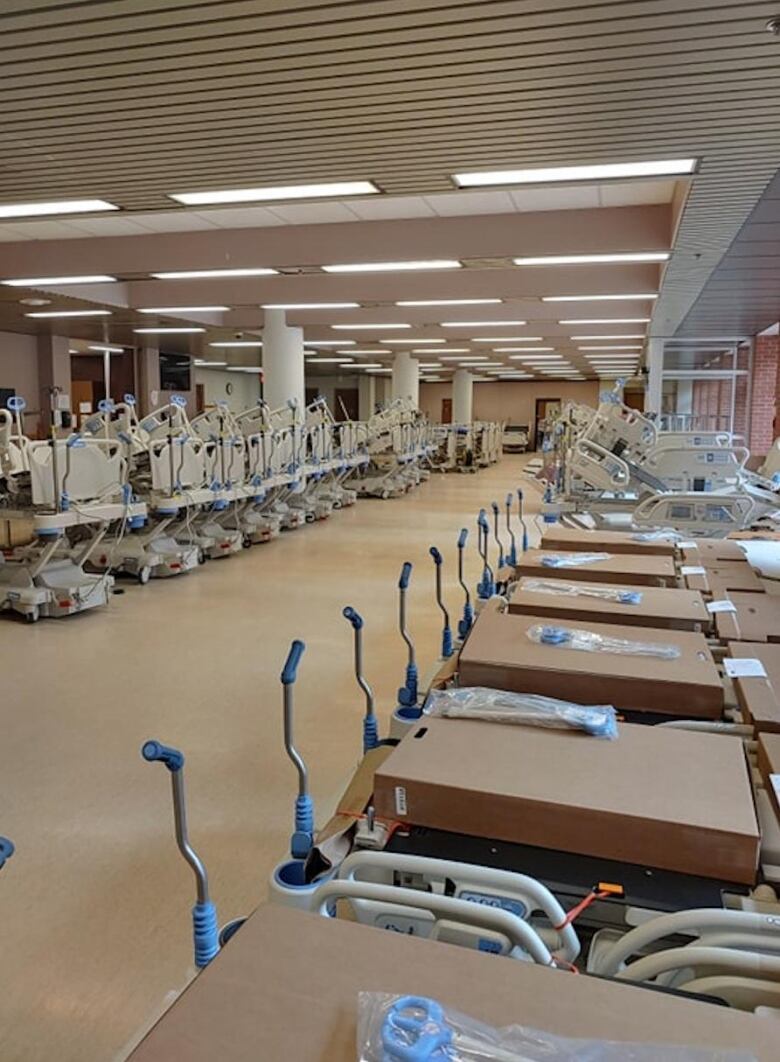COVID-19 in Sask.: No telling yet when province will reach infection peak, premier says
Premier Moe added it's too early to say when restrictive measures will be lifted

Click here for the latest COVID-19 in Sask news: Updates on ventilator supply, masks and equipment for frontline workers
- Saskatchewan has reported its third COVID-19 related death, another elderly person who did not live in a long-term care home.
- The province's total number of cases stands at 193, including 30 recoveries.
- Eight cases have no known source of exposure.
- Health officials are releasing more data breakdowns.
- Grocery storesare adapting to the age of COVID-19.
- The virus is raising questions about assisted dying.
Saskatchewan reported the third coronavirus-related death in the province Wednesday. The total number of COVID-19-related cases to date reached 193, including 30 recoveries.
The latest person who died was aged between 80 and 89, according to a government release, making them the oldest victim of the virus in the province thus far.
At a news conference Wednesday, Premier Scott Moe expressed his condolences for the latest family affected by a death.
He also acknowledged the "strange new way of living" engendered by the virusand said the current need to physically distance from each other could go on for weeks.
"We still have a long way to go," he said,adding that "we may very well have some some increases in the days ahead."
Moe said he did not know when the public health orders in place including the closing of all non-essential services and businesses might be lifted and said it's too early to say when the province might reach its peak in cases.
Here's how the cases (as reported Wednesday)break down regionally.

Orders vs recommendations
During Wednesday's news conference, Dr. Saqib Shahab, Saskatchewan's chief medical health officer, distinguished between public health orders, which are law, and recommendations, which are not law butare still strongly urged.
The province's order that nopublic gatherings of over 10 people take place is an example of the former, Shahab said.
Shahab gave an example of a strong recommendation to go with that order.
"That doesn't mean a house party with nine different people in your basement every day," he said.
The doctor also gave physical distancing advice for families with shared custody of children, an area of life that has heretofore gone unaddressed during his regular news conferences.
"Both parents should [maximize] physical distancing," Shahab said. "Each household should minimize mixing with other households.
"As long as no one in any household is symptomatic, the child is free to move back and forth."
More specific breakdown on cases
The province gave its most specific breakdown of cases yet on Wednesday.
Health officials said 41 of the reported cases are "community contacts,"which includes both people who attended recent events and people who became infected by someone they live with.
Out of those, 24 attendeda 130-person snowmobile supper rally that took place at Christopher Lake, Saskatchewan, on March 14, before a ban on groups of more than 250 people took effect
"We have seen with a couple of large gatherings in this province how quickly people coming together in the 50 or 100 neighborhood can pass this disease off to very large number of people in a very short period of time," Moe said.
The rest of the cases break up as follows:
- Eighty-seven are recent travellers.
- Fifty-seven are still under investigation.
- Eight "have no known exposures."
There are now eight cases with no known source of exposure. The number fluctuates as investigations and contact tracing is completed, officials said Wednesday.
Four people are in hospital, including one Regina patientunder intensive care.
Why is the amount of testing going down?
Shahab was asked Wednesday why the amount of testing in the province has gone down in recent days.
The province reached its testing peak on March 28, with 838 tests performed. Testing in the last three days has average 481, by comparison.
Shahab said that even as the number of communities with testing sites has increased to 37, including some parts of northern Saskatchewan,"thereseems to be a lower demand for testing. We have not been able to ascertain exactly why."
"There's less people who have traveled, who are coming back, who are becoming symptomatic. But at the same time, we are prioritizing testing for people who work in essential services, health care, other services."
Beds stored in cafeteria part of pandemic planning
The Saskatchewan Health Authority (SHA) saidphotos on social media showing new bedsbeing temporarily stored in the cafeteria of Regina General Hospital show one example of how the province ismobilizing "for what may be to come" during the COVID-19 crisis.
"The beds were ordered March 16 aspart of our pandemic response and will be allocated as necessary,"a spokesperson for the health authority said in a statement Wednesday.
"Initial COVID planning includes cohortingCOVID-positive patients in the hospital asrequired.Pandemic planning as it relates to hospital patients is ongoing.This includes exploring options in all SHA facilities."
Thehealth authority also stressed that it's counting on the public to help stave offworst-case pandemic scenarios in Saskatchewan with physical distancing.
"We hope the public will ensure we don't have to live that scenario as a health system,"the statement said.
Photos of the beds began circulating on social media last week.
"Pandemic prep in the RGH cafeteria," read one caption on a Snapchat post.

The health authority said Tuesday that the photos showed a shipment of new, never-used beds that were delivered earlier than expected and were being stored in the cafeteria for the moment.
"The process is the bed would go to the unit, EVS [the Environmental Services staff]would wash/disinfect and then make the bed up with linens," the spokesperson said.
In an early-draft worst-case-scenario planning document addressed last week by health officials, Phase 2 of the health authority's pandemic response plan calls for, among other things, "[repurposing]space in existing facilities to support cohorting in-patient COVID-19 care."
"System preparedness planning has been underway for weeks, as outlined last week in our media conference on March 24, 2020," the spokesperson said Tuesday.
"This does includevarying and specific activities across the province as we beginto mobilize for what may be to come."

Helping prevent a worst-case scenario
The health authority said people may see "system preparedness"already underway, but that an official update on that work will be provided to media in the coming days.
"Regardless of what some may see occurring and what that status update says in the coming days, we cannot stress enough that these activities are for the worst-case scenario."
Wednesday marked three weeks since the province reported its first person infected with the coronavirus.
Since then, Saskatchewan has reported a cumulative total of184 cases, 21 of whom have recovered from the virus. Two people, both in their 70s, have died from COVID-19 complications.
The worst-case-scenario planning document which health officials said is being updated to reflect more Saskatchewan-centric data contemplated a worse death rate of about 3.5 per cent, along witha 30 per cent infection rate in the province.
What the public needs to do
In its statement Tuesday, the health authority said the public still needs to play a pivotal role in ensuring such a scenario doesn't come to pass.
"The public and their actions are our first line of defence," the statement read. "We need every person in Saskatchewan to work together to flatten the curve."
The authority reminded people to stay two metres away from others whenever possible.
"Without this assistance from the public, we won't be able to flatten the curve on the COVID-19 pandemic, which will put our health system in an extremely vulnerable position."
Still reports of non-compliance
In its news release about the eight new cases and seven new recoveries announced Tuesday, the Ministry of Health noted that there are still "reports of people across the province disregarding [public health] directives, which will only increase the amount of time it takes to flatten the curve."
Moe has threatened violators with arrest and a potential $2,000 fine.
The Saskatoon Police Service confirmed Wednesday that no one in the city has been charged for not following a COVID-19 related order.
NDP calls for daycares to close
On Wednesday, Saskatchewan NDP LeaderRyan Meilicalled for the provincial government to shut down childcare centresin the province to "protect" children and caregivers.
On Monday, the YMCA of Regina sent a letter saying it was closing its Northwest and Rochdale childcarecentresfor two weeks because a family member of a child at one of the centres was being tested for COVID-19.
"To slow the spread of COVID-19, we need to close all childcare centres, not just those attached to schools, and we need childcare solutions for essential workers that don't involve grouping those workers' kids together in significant numbers," Meili said.
The NDPis seeking the following measures:
- The immediate closure of all childcare centres, and provision of in-home or very-small-group care for the children of essential workers.
- Provincial grants to childcare centres to ensure that operators can cover expenses and continue to pay staff while closed, without charging parents fees.
- Assurance that no parent will lose their child's space due to COVID-19.
- A provincial wage top-up to childcare workers who are redeployed to care for the children of essential workers.
Moe to donate salary increase to charity
On Wednesday, Saskatchewan MLAs received a scheduled1.7 per cent cost-of-living increase.
Moe said he will donate his increase to charity.
"In light of the current pandemic crisis, I will be donating the entire sum of this increase to Saskatchewan charities, in addition to the amount that I regularly donate. I am encouraging every MLA and cabinet minister to do the same," Moe said in a statement.
The annual salary for an MLA is now $100,068, up from$98,395.
Moe, like many other MLAs, receives extra allowances for duties performed. Hemade$169,958 in 2019.His salary with the increase is$172,848.
Meili's salary with allowances is $151,015.Meili saidhe will be donating his salary increase to The Lighthouse in Saskatoon and other organizations helping those in need.
MLAs received a 2.3 per cent cost-of-living increase as of April 1, 2019.












_(720p).jpg)


 OFFICIAL HD MUSIC VIDEO.jpg)
.jpg)



























































































